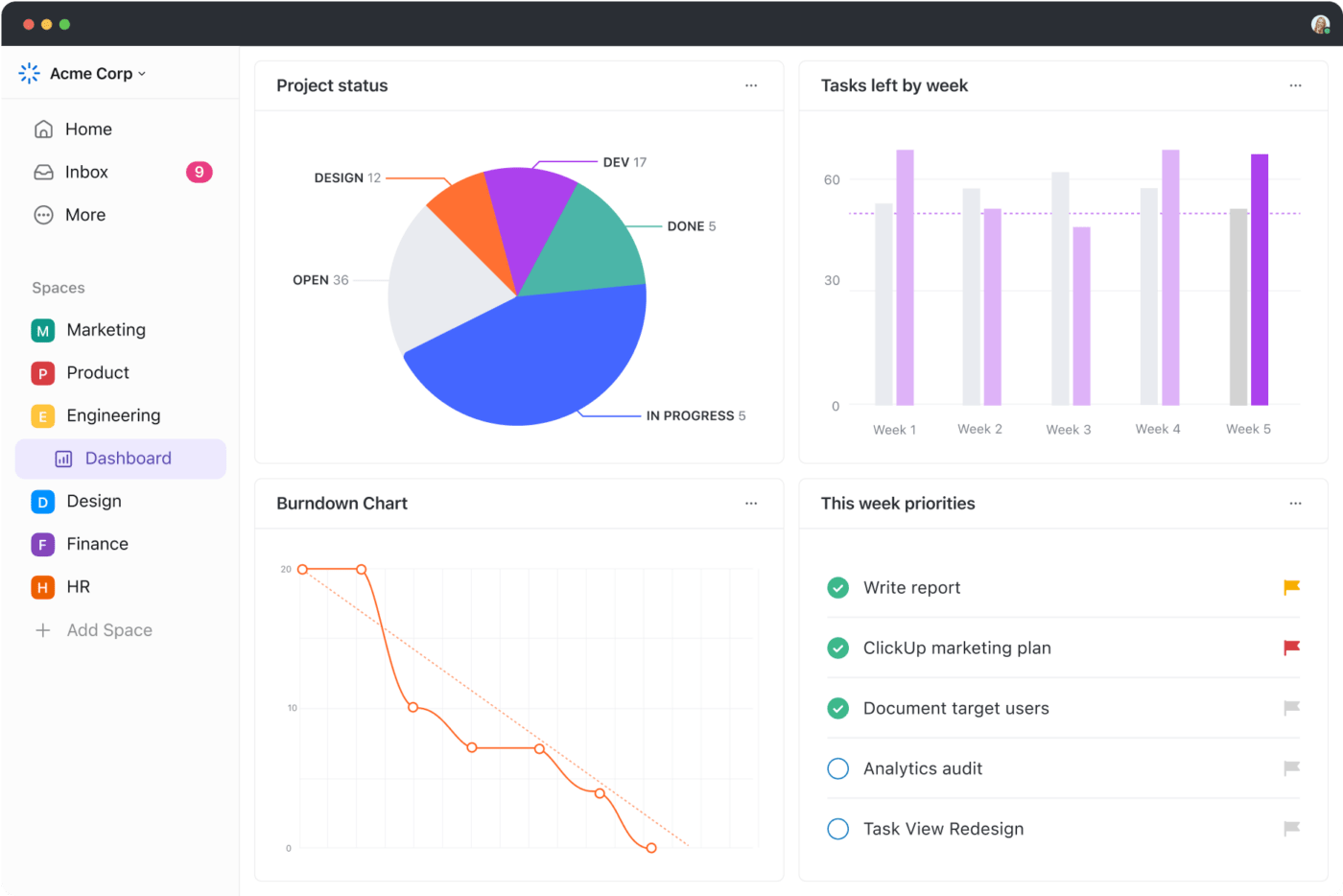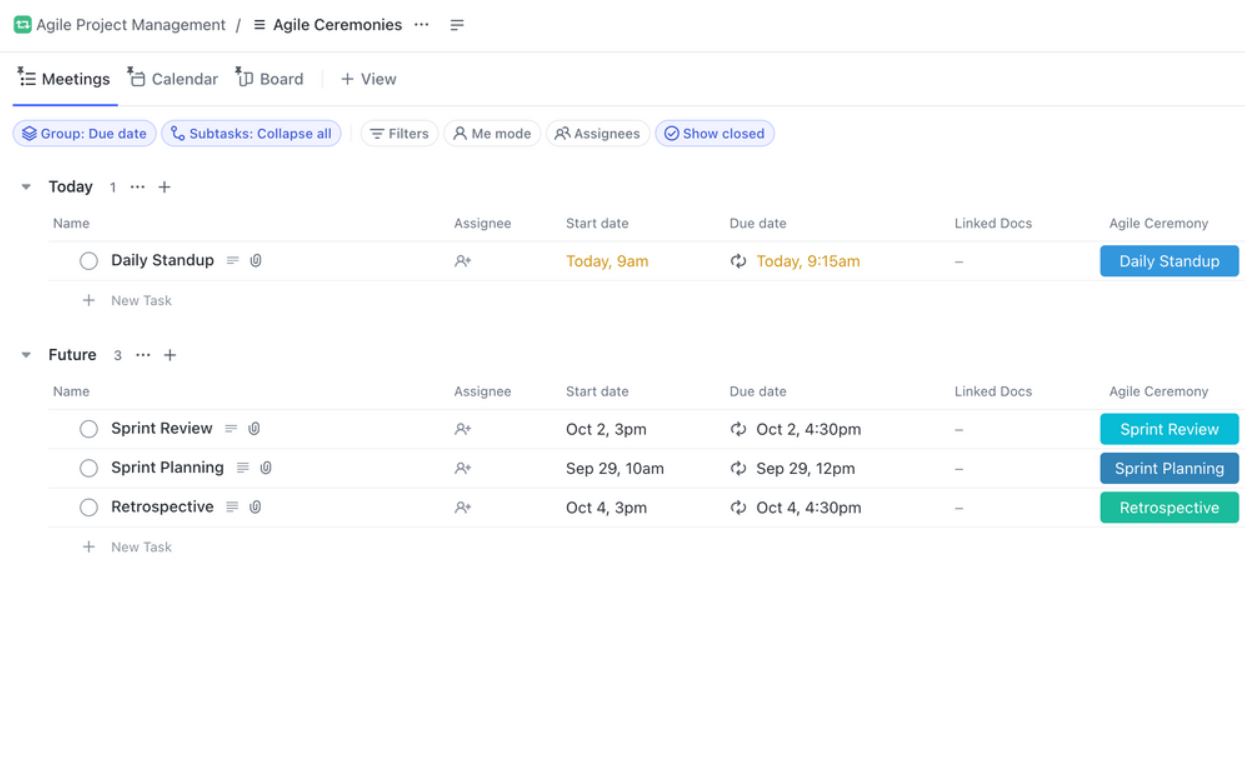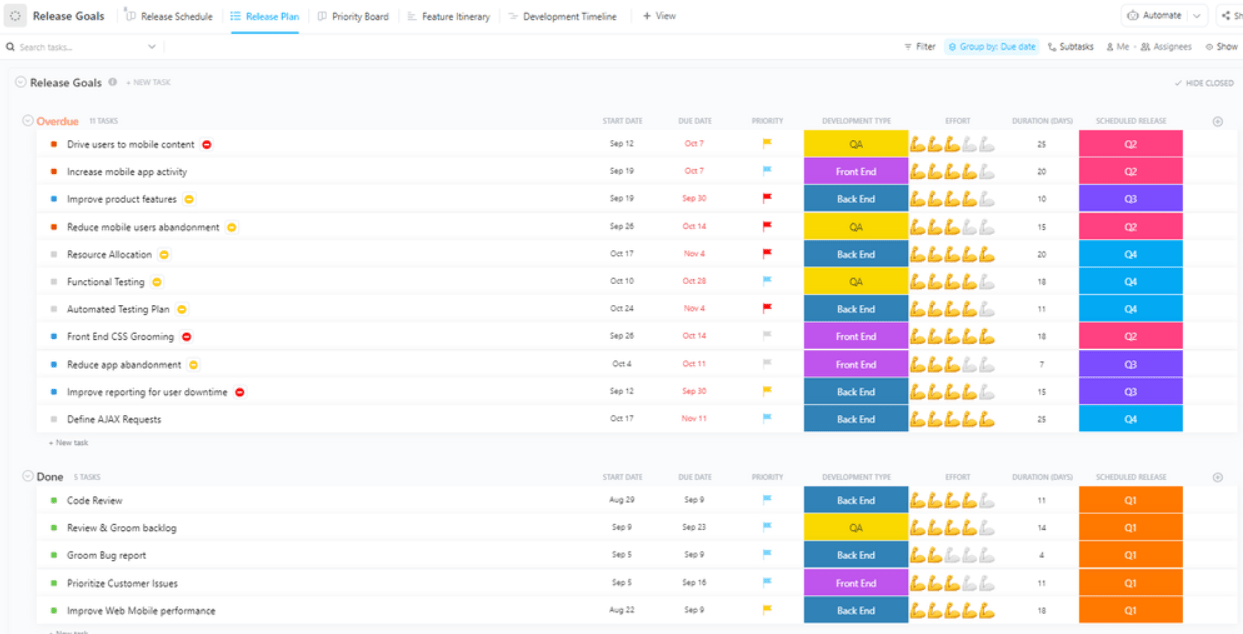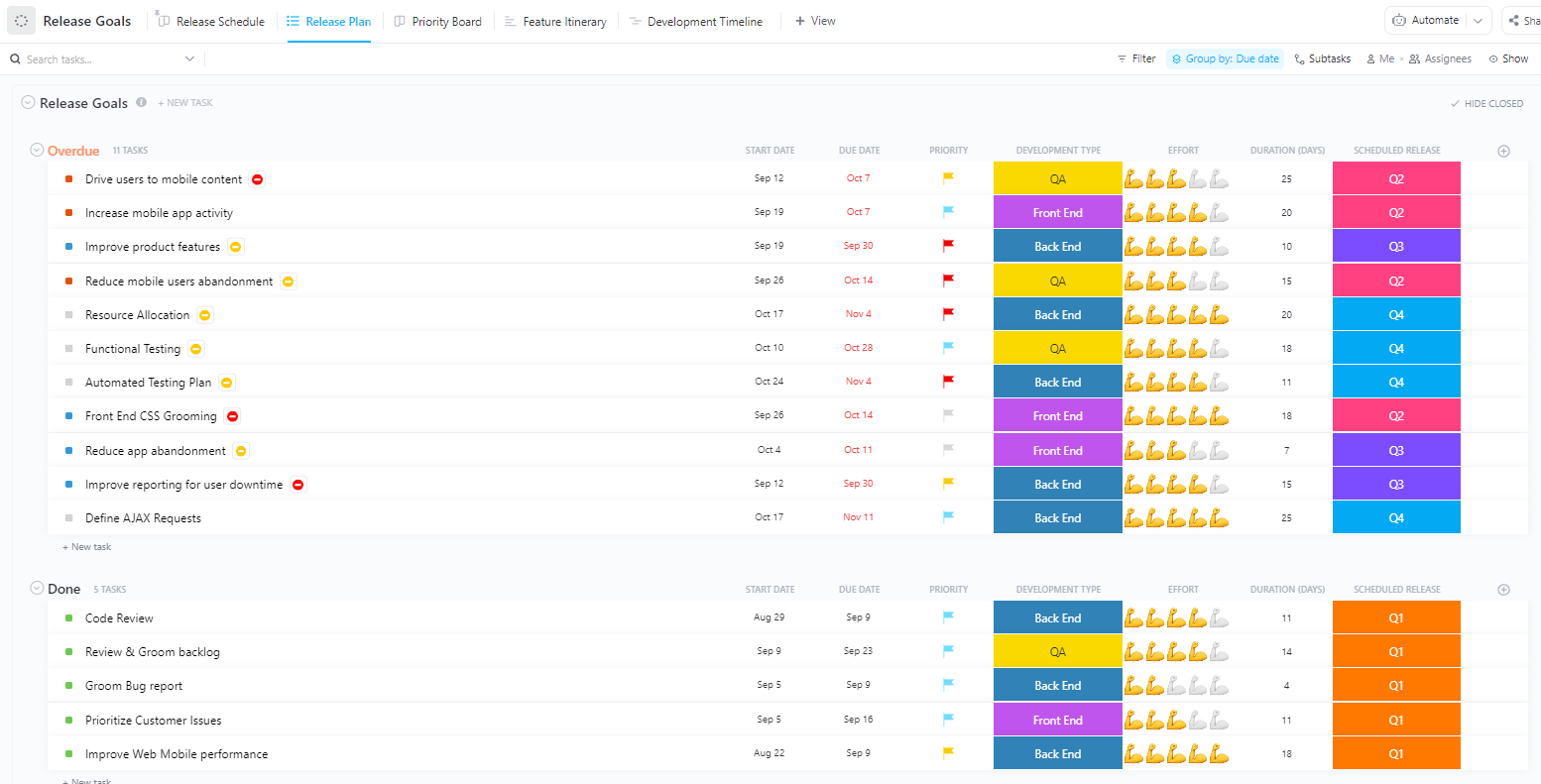كل منتج يبدأ بخطة. في عالم مثالي، يمكنك متابعة هذه الخطة من البداية إلى النهاية. لكن في الواقع، قد تؤدي مشكلة واحدة في بعض الأحيان إلى تعطيل الجدول الزمني بأكمله والتأثير على المواعيد النهائية وتغيير ديناميكيات الفريق.
يمكن لتخطيط الإصدار الرشيق أن يمهد الطريق لنجاح فريقك. فهو يقسّم مشروع إصدار منتجك إلى أجزاء أصغر وأسهل في الإدارة (التكرارات وسباقات السرعة)، مع التركيز على التقدم المستمر والتعديلات.
في هذه المقالة، سنغطي كيفية تنظيم إصداراتك المستقبلية ونقترح طرقًا لتحسين عملية التطوير الخاصة بك.
ما هو تخطيط الإصدار الرشيق؟
تخطيط الإصدار الرشيق هو طريقة لإدارة المشاريع التي تركز على إصدارات المنتجات الإضافية بدلاً من الإصدارات الرئيسية.
دعنا نرجع إلى الوراء ونوضح الجزء "الرشيق" من المصطلح. إنها واحدة من أكثر منهجيات إدارة المشاريع شيوعًا استنادًا إلى مبادئ أساسية مثل المرونة والقدرة على التكيف والتعاون.
مع أجايل، تقوم بتقسيم مشروعك إلى عدة مراحل. يساعدك إكمال مشروعك خطوة بخطوة على "الاستماع" إلى السوق، وجمع ملاحظات العملاء، والتكيف معها وفقًا لذلك. تمنحك الطريقة الرشيقة القدرة على الاستجابة للتغييرات المحتملة دون الحاجة إلى إعادة التفكير في الخطط طويلة المدى.
يتمحور تخطيط الإصدار الرشيق حول تقسيم دورة التطوير الرشيق إلى مراحل عديدة (إصدارات). ويستند كل إصدار على التغذية الراجعة من الإصدار السابق، مما يسمح لك بتحديد اتجاه مشروعك وإجراء التغييرات المناسبة لتقديم منتج عملي. تخطيط الإصدار الرشيق شائع في تطوير البرمجيات، لأنه نهج يركز على العميل ويسمح بالتكيف مع المتطلبات المتغيرة. يمكن أن يساعدك تطبيقه في الحفاظ على عملية تطوير المنتج على المسار الصحيح والتأكد من أن ما يقوم به فريقك يتماشى مع ما يريد العملاء المستهدفون رؤيته.
تخطيط إصدار Scrum
يشير بعض الناس إلى تخطيط الإصدار الرشيق على أنه تخطيط إصدار سكروم، والذي يمكن أن يثير الارتباك - هل أجايل سكرم, هو سكرم رشيق ? هل هذان المصطلحان قابلان للتبادل؟
يقع Scrum تحت مظلة أجايل ويجلب الهيكلية للمشروع. فهو يسمح للفرق بتقسيم العمل إلى مراحل تسمى سباقات السرعة وتحديد الأدوار وتنظيم العمل لتتبع التقدم المحرز بسهولة.
ببساطة، يمثل Scrum طريقة لتطبيق فلسفة أجايل.
لماذا يعتبر تخطيط الإصدار الرشيق مهمًا؟
يتزايد عدد الفرق التي تتبع منهجية أجايل لأنها أدركت أهمية وفوائد هذه المنهجية. دعنا نوضح ما الذي يجعل تخطيط الإصدار الرشيق ذا قيمة كبيرة في مشهد إدارة المشاريع اليوم.
المرونة
يمكن أن تؤثر الخطط الجامدة طويلة الأجل التي لا تتسم بالمرونة على جودة المنتج النهائي لأنها لا تأخذ في الاعتبار احتياجات السوق المتغيرة باستمرار. تتمحور خطة الإصدار الرشيقة حول المرونة. فهي تسمح لك ولفريقك بالتكيف بسرعة مع المتطلبات الجديدة وتقديم ما يتوقعه العملاء ويريدونه بالضبط، دون المخاطرة بإهدار أسابيع وشهور من العمل.
ضغط وإرهاق أقل
نظرًا لأن تخطيط الإصدار الرشيق ينطوي على تقسيم المشروع إلى العديد من التكرارات، فإن أعضاء الفريق يتمتعون بأعباء عمل أسهل في الإدارة و تقييمات متكررة. الجودة هي الأولوية، لذلك لا يشعر الأشخاص بالضغط لتقديم عملهم "بالأمس"
تحسين تعاون الفريق
الاجتماعات القصيرة والمتكررة تفعل المعجزات من أجل تعاون الفريق وجعل الموظفين يشعرون بتقديرهم وإشراكهم في الأنشطة اليومية. والأهم من ذلك، تضمن هذه الاجتماعات فهم الجميع لواجباتهم وتمنع سوء الفهم أو سوء التواصل.
كيفية تنفيذ تخطيط الإصدار الرشيق
يجب على فريق التطوير استخدام أدوات متخصصة لدمج أفضل ممارسات الأسلوب الرشيق في عملياتهم اليومية. سنرشدك خلال عملية اعتماد إدارة المشاريع الرشيقة باستخدام واحدة من أفضل الأدوات المتاحة- انقر فوق .
ClickUp عبارة عن منصة شاملة لإدارة المشاريع والإنتاجية تسمح لك بإبقاء فريقك على نفس الصفحة وإنشاء وتنظيم وإدارة سباقات السرعة, تحسين سير العمل و إدارة الإصدارات مثل المحترفين!
استفد من ميزات ClickUp المتنوعة واتبع الخطوات أدناه لتحقيق أقصى استفادة من تخطيط الإصدارات الرشيقة.

توفر لوحات المعلومات في ClickUp 3.0 لمديري المشاريع الرشيقة عرضًا سريعًا للمهام والأولويات المتبقية للفريق خلال الأسبوع بالإضافة إلى مخططات تفصيلية لمراحل التنفيذ والتراجع
الخطوة 1: تحديد رؤية المشروع وتحديد النتائج
قبل أن تتمكن فعليًا من الوصول إلى تخطيط الإصدار الرشيق، يجب أن يكون لديك رؤية للمشروع وترجمتها إلى أهداف واضحة وشفافة للإصدار.
تعكس الرؤية كيفية رؤيتك لمنتجك ويجب أن تتماشى مع خارطة طريق المنتج . يجب أن تأخذ في الاعتبار احتياجات عملائك ومتطلباتهم والعرض الحالي في السوق. تتحول رؤيتك إلى نتائج، حيث ستحدد أولويات الإصدار. إدارة المشاريع الرشيقة في ClickUp يمكن أن تساعدك على القيام بكل ما سبق بكل سهولة. تتمحور هذه المجموعة حول تدفقات العمل الرشيقة وتمنحك مساحة أكثر من كافية لمناقشة وتحديد رؤية المنتج، مع مراعاة احتياجات السوق وتوافر فريقك.
استخدم ClickUp Whiteboards (اللوحة الرقمية الخاصة ب ClickUp) لتبادل الأفكار وتحديد الأولويات وتحويل أفكارك إلى مهام.

حوِّل أفكارك إلى مهام داخل ميزة ClickUp Whiteboard
الخطوة 2: تنقيح المهام المتراكمة
الآن بعد أن قمت بتحديد النتائج، حان الوقت لمراجعة المهام المتراكمة تراكم المنتجات و تحديد أولويات المهام . يجب الاهتمام بميزات المنتج الأكثر أهمية أولاً، بينما تأتي الميزات الأقل أهمية في النهاية.
نقطة البداية هي الحد الأدنى من المنتج القابل للتطبيق، أي منتج يحتوي على ميزات كافية لجذب العملاء. بعد تلقي ملاحظات العملاء، ستقوم بإضافة ميزات إضافية لجعل المنتج أكثر فاعلية وقيمة.
هذه أيضًا هي المرحلة التي ستضع فيها قصص المستخدم. فهي تصف ميزات منتجك من وجهة نظر المستخدم النهائي وتؤكد على قيمتها. تحافظ قصص المستخدم على تركيز فريقك على العميل وتمنعهم من العمل على ميزات لن تكون مفيدة.
تجعل ميزات ClickUp Agile من إكمال هذه الأنشطة نزهة في الحديقة. استخدم عرض القائمة لتحديد جميع الميزات التي يجب أن يمتلكها منتجك وتحديد أولويتها. قم بالتبديل إلى لوحة كانبان لرؤية الميزات المتراكمة في منتجك مصنفة حسب حالتها.
استخدم انقر فوق الحقول المخصصة والصيغ لتفصيل كل ميزة، وإضافة أعضاء الفريق المعنيين إلى مساحة العمل الخاصة بك، وتبسيط التعاون. مكتبة ClickUp التي تضم أكثر من 1000 قالب نقطة انطلاق ممتازة إذا كنت ترغب في جعل إدارة الأعمال المتراكمة للمنتج وتحديد قصص المستخدمين أسهل. تحتوي القوالب على أقسام معدة مسبقًا تعمل كمبادئ توجيهية وتضمن عدم سقوط أي معلومات مهمة من خلال الشقوق.

استخدم ClickUp لإنشاء طريقة عرض قائمة المنتجات المتراكمة التي تحتوي على حقول مخصصة مثل الأولوية و ARR والمزيد
الخطوة 3: عقد اجتماع تخطيط الإصدار وتحديد الهدف
بمجرد الانتهاء من تنقيح الأعمال المتراكمة، حان الوقت لتعيين هدف واضح لتخطيط الإصدار بناءً على قصص المستخدمين. قم بذلك من خلال إعداد اجتماع مع أصحاب المصلحة. إذا لزم الأمر، يمكنك أنت وفريقك تغيير الخطة الأولية للتأكد من أن الهدف منطقي وواقعي.
أثناء الاجتماع، يجب عليك مراجعة ومناقشة خارطة طريق المنتج وبنيته، وتقسيم العمل إلى سباقات السرعة وتقدير السرعة والجدول الزمني (بناءً على مشاريعك السابقة) لتحديد توزيع العمل ونطاق الإصدار.
الميزة التي ستجدها لا تقدر بثمن عند التخطيط للسباق السريع هي انقر فوق سباقات السرعة . استخدمه لتحديد تواريخ السباقات، وتعيين النقاط، وتحديد الأولويات, إدارة أعباء العمل وأتمتة العمل غير المكتمل. قم بتكرار عرض Sprint وإنشاء سباقات السرعة تلقائيًا لتوفير الوقت.
يمكن أن تكون قوالب ClickUp مفيدة أيضًا في إنشاء وإدارة سباقات السرعة. أفضل اختياراتنا هي قالب ClickUp Sprints و قالب ClickUp Simple Sprints .
يمكن ل ClickUp AI إنشاء أنواع لا حصر لها من المستندات مثل ملخصات المشاريع، وخطط الدروس، وغيرها من المستندات لتسريع سير عملك
ميزة أخرى من ميزات ClickUp التي يمكن أن تساعدك خلال هذه المرحلة من عملية إدارة الإصدار هي مستندات ClickUp -منصة فريدة من نوعها لإدارة المستندات. هذا هو المكان الذي يمكنك فيه إنشاء وتحرير ومشاركة وحفظ جميع المستندات المتعلقة بتخطيط الإصدار السريع.
قم بإنشاء مستند ClickUp Doc لاجتماع تخطيط الإصدار الخاص بك، وأضف أصحاب المصلحة، واستعرض الخطة بالتفصيل لمعرفة ما إذا كان يمكن تحسينها وكيف يمكن تحسينها. مع خيارات مثل التحرير في الوقت الفعلي وترك التعليقات، يمكن لفريقك التعاون بسلاسة حتى لو لم تكن في نفس الموقع.
يأتي ClickUp Docs مع خيار إضافي سيجعل عملك أسهل من نواحٍ عديدة - ClickUp AI مساعد قوي في الكتابة. يمكن أن يساعدك في إنشاء جداول أعمال الاجتماعات، وتلخيص الملاحظات من اجتماع تخطيط الإصدار، والعصف الذهني للأفكار، وهذا مجرد غيض من فيض!
يمكن ل ClickUp AI دعم سير العمل الرشيق من خلال مساعدتك في إنشاء الجداول الزمنية للمشروع وإشراك العملاء في عملياتك وتنفيذ ملاحظاتهم، مما يجعله سلاحًا ممتازًا آخر في ترسانتك الرشيقة. ⚔️
الخطوة 4: أكمل تقويم إصدار المنتج #### ### الخطوة 4: أكمل تقويم إصدار المنتج
راجع سباقات السرعة والتكرارات الخاصة بك، وتأكد من أنها ذات الطول الأمثل، وقم بإجراء التعديلات إذا لزم الأمر. لا تنسى ما هو كل ما يدور حوله نظام أجايل - إجراء التغييرات أثناء تقدمك للالتزام باحتياجات العملاء المتطورة ومتطلبات السوق.
حدد ما ينجح وما لا ينجح من خلال إعادة النظر في عمليات استرجاع السرعة وتتبع مقاييس رشيقة لمراقبة خططك وتحديثها بشكل سريع.
تحديات تخطيط الإصدار الرشيق ## تحديات تخطيط الإصدار الرشيق
يحسّن تخطيط الإصدار الرشيق من تركيز فريقك ويضمن توافق منتجك مع احتياجات عميلك، مما يقلل من مخاطر إضاعة الوقت على ميزات غير مجدية. ومع ذلك، مثل أساليب إدارة المشاريع الأخرى، فإن تخطيط الإصدار الرشيق ليس مثاليًا. هناك بعض التحديات المحتملة التي يجب أن تكون على دراية بها من أجل التخفيف من حدتها على طول الطريق.
البدء بدون خبرة سابقة
يصبح تخطيط الإصدار الرشيق أسهل مع تقدمك لأنه يمكنك الاعتماد على خبرتك السابقة لتحديد عبء العمل الذي يمكن لفريقك التعامل معه في فترة زمنية محددة. بدون هذه الفائدة من الإدراك المتأخر، لا يمكنك أن تعرف على وجه اليقين المدة التي سيستغرقها سباق أو تكرار سريع، لذلك قد تحتاج إلى اللجوء إلى التجربة والخطأ وتعديل خططك بشكل متكرر أثناء تقدمك.
عدم اليقين
نظرًا لأن تخطيط الإصدار الرشيق يتمحور حول التكيف مع احتياجات السوق، فأنت لا تعرف أبدًا ما الذي ينتظرنا في المستقبل. لا شيء مؤكد، و التخطيط لعدم اليقين أقل ما يقال عنه أنه صعب. يجب أن تكون مستعدًا لتغيير خطة لعبتك عندما لا تتوقع ذلك، وعنصر المفاجأة هذا ليس من الأمور التي يحبها الجميع. ☕
عدم التركيز
نعم، يجب أن يعزز التخطيط الرشيق للإصدار من تركيز فريقك. ولكن من المفارقات أنه يمكن أن يقلل منه أيضًا. يمكن أن تؤثر التغييرات المتكررة وتغيير الأولويات على التركيز وأداء الفريق.
الحفاظ على التواصل
التواصل أمر حيوي في تخطيط الإصدار الرشيق. إذا لم يكن أحد أعضاء الفريق على علم بآخر التغييرات، فلن يسعى إلى تحقيق نفس الأهداف، مما يؤثر على جهود الفريق بأكمله. هذا هو السبب في أن الاجتماعات المتكررة جزء لا يتجزأ من الحفاظ على سير العمل الرشيق.
أمثلة ونماذج لتخطيط الإصدار الرشيق
لا توجد طريقة أفضل لفهم تخطيط الإصدار الرشيق من مثال واقعي. لنفترض أن فريقك يريد طرح منصة بث وسائط جديدة باستخدام الإدارة الرشيقة للمشروع.
كما رأينا، البند الأول على جدول أعمالك هو تحديد رؤية المشروع ونتائجه. على سبيل المثال، أنت تريد أن تكون المنصة سهلة الاستخدام وأن تقدم تجربة مشاهدة فريدة من نوعها من خلال محتوى بأكثر من 20 لغة ومجموعة واسعة من البرامج التلفزيونية والأفلام. وباستخدام ClickUp Agile، ستنشئ تراكماً للمنتجات، حيث ستدرج قصص المستخدمين والمهام مثل "إعداد عملية التسجيل" و"إضافة CC" و"تكوين أزرار الترجيع والتخطي للأمام" و"إضافة عناوين جديدة إلى المكتبة"
بعد ذلك، تحتاج إلى تنقيح الأعمال المتراكمة وتنظيم العناصر بناءً على أولويتها. ستعقد اجتماعًا لتخطيط الإصدار لمناقشة ما ستركز عليه أولاً وتحديد هدفك الأساسي - إنشاء منصة بث وسائط سهلة الاستخدام في غضون ستة أشهر.
ستقوم بتدوين الملاحظات باستخدام ClickUp Docs و ClickUp AI. ستستخدم أيضًا ClickUp Sprints لتقسيم عملك إلى سباقات سريعة، وتحديد التواريخ، وتعيين النقاط. على سبيل المثال، سوف تقوم بتقسيم مهمة "إعداد عملية التسجيل" إلى سباقات سريعة مثل "تصميم صفحة التسجيل" و"إعداد قاعدة البيانات" و"تطوير النهاية الخلفية"

استخدم طريقة عرض ClickUp Board لتقييم الأعمال المتراكمة وتحديد أولوياتها باستخدام الحقول والصيغ المخصصة
سوف تستكمل تقويم إصدار المنتج وتضع خطتك قيد التنفيذ. بعد ذلك، ستعقد اجتماعات منتظمة لتتبع نجاح العمل المنجز. على سبيل المثال، قد تلاحظ على سبيل المثال أنه يمكن تحسين تصميم صفحة التسجيل، لذلك ستقوم بتعديل خططك وفقًا لذلك. بعد فترة، سترى أن احتياجات السوق قد تطورت - فالناس يريدون الاستماع إلى البودكاست أكثر. لذا، ستفكر في إضافة هذه الميزة إلى منصتك لجذب المزيد من المستخدمين وإبقائهم سعداء.
يمكن لقوالب ClickUp أن تجعل عملك أسهل
من ClickUp Agile إلى ClickUp Docs مع مساعد قوي للكتابة بالذكاء الاصطناعي، تقدم ClickUp ميزات تبسط تخطيط الإصدار السريع. تستحق مكتبة قوالب المنصة تنويهًا فخريًا - فهي تحتوي على خيارات مصممة خصيصًا لفرق العمل الرشيقة، مما يعزز أداءها مع توفير الوقت.
دعنا نلقي نظرة على قالبين من قوالب ClickUp يجب عليك الاستفادة منهما إذا كنت ترغب في إتقان تخطيط الإصدار الرشيق.
1. نموذج ClickUp Agile لإدارة المشاريع الرشيقة

يدعم قالب ClickUp Agile Project Management قالب إدارة المشاريع الرشيقة تدفقات العمل الرشيقة ويبقي فريقك على نفس الصفحة
هل تدير مشروعًا غير برمجي؟ مشروع تطوير وتريد تطبيق منهجيات رشيقة؟ إن نموذج ClickUp Agile لإدارة المشاريع الرشيقة هو الطريق الصحيح!
يوفر هذا القالب الأساس المثالي لتطبيق منهجيات مثل Scrum و Kanban بأقسامه الخمسة:
- القائمة الخلفية: جمع الطلبات باستخدام نموذج ClickUp ونقل المعلومات تلقائيًا إلى قائمة حيث يمكنك تحديد أولويات العناصر المتراكمة
- احتفالات أجايل: إدارة الاحتفالات مثل الاستعراضات بأثر رجعي، والوقوف اليومي، ومراجعات العدو السريع
- لوحة كانبان: قم بتحويل مهامك إلى بطاقات وفرزها حسب الحالة لتتبع سير عملك
- إعداد سباقات السرعة: إنشاء مجلدات سباقات السرعة وإضافة المهام إلى سباقات السرعة وتقدير العمل وإدارة الموارد بسهولة
مثل جميع قوالب ClickUp، يدعم هذا النموذج تعاون الفريق ويوفر المرونة. يمكنك ضبطه حسب ديناميكيات فريقك والأساليب المحددة التي تستخدمها لإنجاز العمل. 💪
2. قالب تخطيط إصدار ClickUp

استخدم قالب تخطيط الإصدار ClickUp لتخطيط إصدار برنامج جديد وإدارته بسهولة
قد يكون التوصل إلى الاستراتيجيات الصحيحة لإصدار برنامجك الجديد أمراً صعباً إذا لم تكن لديك الأدوات المناسبة تحت تصرفك. إن قالب تخطيط إصدار ClickUp هو بالضبط ما تحتاج إليه إدارة منتجك و تحديد استراتيجيات الإصدار بأقل قدر من الانتكاسات.
باستخدام هذا القالب، يمكنك تخطيط مهامك، والبقاء منظمًا وضمن المواعيد النهائية، وتتبع تقدمك بمرور الوقت لمعرفة ما إذا كان هناك مجال للتحسين. 😍
هذا القالب عبارة عن قالب مجلد يحتوي على ثلاثة مكونات - الميزات، وأهداف الإصدار، وملاحظات الإصدار.
يقدم قسم الميزات عرضين. يتيح لك الخيار الأول (أهداف الإصدار) تحديد الأعمال المتراكمة للمنتج ومرحلة التكرار والتأثيرات الرئيسية، بينما يعرض الخيار الثاني (لوحة التكرار) مهامك كبطاقات مرتبة حسب التكرار.
يحتوي قسم أهداف الإصدار على خمس طرق عرض - جدول الإصدار، وخطة الإصدار، ولوحة الأولويات، ومسار خط سير الميزات، والجدول الزمني للتطوير. استخدمها لتنظيم وتلخيص وإدارة مهامك وتتبع التبعيات وإنشاء جداول زمنية منطقية.
قسم ملاحظات الإصدار عبارة عن مستند نقر فوق مستند حيث يمكنك تضمين موارد إضافية أو تقديم المزيد من التفاصيل حول إطلاق منتجك.
تخطيط الإصدار الرشيق: خطوات صغيرة نحو أهداف كبيرة
يساعدك تخطيط الإصدار الرشيق على التوافق مع احتياجات عميلك وإنشاء منتج وظيفي بدون ميزات زائدة عن الحاجة. توفر المنهجية المرونة وتقدر العمل الجماعي والتواصل.
هذه هي أيضاً الفلسفة التي تقوم عليها منصة ClickUp! ليس من المستغرب أن تكون المنصة مليئة بالعديد من الخيارات التي تدعم سير العمل الرشيق وتجعل خطط الإصدار الرشيق في غاية السهولة، بدءاً من ClickUp Agile و ClickUp Sprints إلى مئات القوالب التي تجعل عملك أسهل. اشترك في ClickUp وابدأ في تنفيذ تخطيط الإصدار الرشيق اليوم! 🥰

